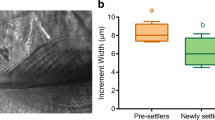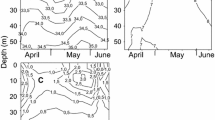Abstract
Sublethal predation can be a significant trophic pathway in sediment communities, and the regeneration of damaged tissue affects the activity, growth, and reproduction of prey. A field experiment was conducted 12–18 July 2010 in the Tijuana Estuary, California (+32.56617°, −117.13152°), to measure in situ rates of body growth and palp regeneration of the polychaete Polydora cornuta after simulating sublethal predation by removing 2, 1, or 0 palps from labeled individuals. After 3 days in the field, individuals that had 2 palps removed grew significantly slower than worms that had 0 palps removed; 1-palp worms had intermediate growth. After 6 days in the field, rates of body growth were faster than those of worms recovered after 3 days, with similar trends among the three palp treatments. During the 3-day transplantation, removed palps regenerated to half the initial length of unmanipulated palps. After 6 days, palp lengths did not differ significantly among treatment groups, indicating complete regeneration. The regeneration rate of removed palps was significantly faster than the growth rate of undamaged palps, and palp regeneration rate did not differ significantly between worms that had 1 or 2 palps removed.



Similar content being viewed by others
References
Aller RC (1982) The effects of macrobenthos on chemical properties of marine sediment and overlying water. In: McCall PL, Tevesz MJS (eds) Animal-sediment relations. Plenum, New York, pp 53–102
Bely AE, Nyberg K (2010) Evolution of animal regeneration: re-emergence of a field. Trends Ecol Evol 25:161–170. doi:10.1016/j.tree.2009.08.005
Berke SK, Cruz V, Osman RW (2009) Sublethal predation and regeneration in two onuphid polychaetes: patterns and implications. Biol Bull 217:242–252
Blake JA, Maciolek NJ (1987) A redescription of Polydora cornuta Bosc (Polychaeta: Spionidae) and designation of a neotype. Bull Biol Soc Wash 7:11–15
Bock MJ, Miller DC (1996) Fluid flow and suspended particulates as determinants of polychaete feeding behavior. J Mar Res 54:565–588. doi:10.1357/0022240963213547
Bolam SG, Fernandes TF (2003) Dense aggregations of Pygospio elegans (Claparede): effect on macrofaunal community structure and sediments. J Sea Res 49:171–185. doi:10.1016/S1385-1101(03)00007-8
Bowmer T, Keegan BF (1983) Field survey of the occurrence and significance of regeneration in Amphiura filiformis (Echinodermata; Ophiuroidea) from Galway Bay, west coast of Ireland. Mar Biol 74:65–71. doi:10.1007/BF00394276
Clavier J (1984) Production due to regeneration by Euclymene oerstedi (Claparede) (Polychaeta: Maldanidae) in the maritime basin of the Rance (Northern Brittany). J Exp Mar Biol Ecol 75:97–106. doi:10.1016/0022-0981(84)90174-6
Clements LAJ (1985) Post-autotomy feeding behavior of Micropholis gracha (Stimpson): implications for regeneration. In: Keegan BF, O’Connor BDS (eds) Proc 5th International Echinoderm Conference, Galway. Ireland, AA Balkema, pp 609–615
Clements LAJ, Bell SS, Kurdziel JP (1994) Abundance and arm loss of the infaunal brittlestar Ophiophragmus filograneus (Echinodermata: Ophiuroidea), with an experimental determination of regeneration rates in natural and planted seagrass beds. Mar Biol 121:97–104. doi:10.1007/BF00349478
Colvin MA, Hentschel BT (2011) Seasonal variability in the juvenile growth rate of an infaunal polychaete is related to major rain events. Limnol Oceanogr 56:2095–2102. doi:10.4319/lo.2011.56.6.2095
Dauer DM, Maybury CA, Ewing RM (1981) Feeding behavior and general ecology of several spionid polychaetes from the Chesapeake Bay. J Exp Mar Biol Ecol 54:21–38. doi:10.1016/0022-0981(81)90100-3
de Vlas J (1979a) Annual food intake by plaice and flounder in a tidal flat area in the Dutch Wadden Sea, with special reference to consumption of regenerating parts of macrobenthic prey. Neth J Sea Res 13:117–153. doi:10.1016/0077-7579(79)90037-1
de Vlas J (1979b) Secondary production by tail regeneration in a tidal flat population of lugworms (Arenicola marina), cropped by flatfish. Neth J Sea Res 13:362–393. doi:10.1016/0077-7579(79)90012-7
de Vlas J (1985) Secondary production by siphon regeneration in a tidal flat population of Macoma balthica. Neth J Sea Res 19:147–164. doi:10.1016/0077-7579(85)90019-5
Edwards R, Steele JH (1968) The ecology of 0-group plaice and common dabs at Loch Ewe I. Population and food. J Exp Mar Biol Ecol 2:215–238. doi:10.1016/0022-0981(68)90017-8
Fisher RA (1921) Some remarks on the methods formulated in a recent article on the quantitative analysis of plant growth. Ann Appl Biol 7:367–372. doi:10.1111/j.1744-7348.1921.tb05524.xd
Hentschel BT (2004) Sediment resuspension and boundary layer flow dramatically enhance the growth rates of interface-feeding spionid polychaetes. J Mar Syst 49:209–224. doi:10.1016/j.jmarsys.2003.08.007
Hentschel BT, Harper NS (2006) Effects of simulated sublethal predation on the growth and regeneration rates of a spionid polychaete in laboratory flumes. Mar Biol 149:1175–1183. doi:10.1007/s00227-006-0274-8
Hentschel BT, Herrick BS (2005) Growth rates of interface-feeding spionid polychaetes in simulated tidal currents. J Mar Res 63:983–999. doi:10.1357/002224005774464184
Hentschel BT, Larson AA (2005) Growth rates of interface-feeding polychaetes: combined effects of flow speed and suspended food concentration. Mar Ecol Prog Ser 293:119–129. doi:10.3354/meps293119
Hentschel BT, Larson AA (2006) Hydrodynamic mediation of density-dependent growth and adult-juvenile interactions of a spionid polychaete. Limnol Oceanogr 51:1031–1037. doi:10.4319/lo.2006.51.2.1031
Kamermans P, Huitema HJ (1994) Shrimp (Crangon crangon L.) browsing upon siphon tips inhibits feeding and growth in the bivalve Macoma balthica (L.). J Exp Mar Biol Ecol 175:59–75. doi:10.1016/0022-0981(94)90176-7
Karhan SU, Kalkan E, Simboura N, Mutlu E, Bekbolet M (2008) On the occurrence and established populations of the alien polychaete Polydora cornuta Bosc, 1802 (Polychaeta: Spionidae) in the Sea of Marmara and the Bosphorus Strait (Turkey). Medit Mar Sci 9:5–19
Lindsay SM (2009) Ecology of injury in marine soft sediment communities: methyl green staining improves identification of regenerating spionid polychaetes. Integr Comp Biol 49:E263
Lindsay SM (2010) Frequency of injury and the ecology of regeneration in marine benthic invertebrates. Integr Comp Biol 50:479–493. doi:10.1093/icb/icq099
Lindsay SM, Woodin SA (1992) The effect of palp loss on feeding behavior of two spionid polychaetes: changes in exposure. Biol Bull 183:440–447. doi:10.2307/1542020
Lindsay SM, Woodin SA (1995) Tissue loss induces switching of feeding mode in spionid polychaetes. Mar Ecol Prog Ser 125:159–169. doi:10.3354/meps125159
Lindsay SM, Wethey DS, Woodin SA (1996) Modeling interactions of browsing predation, infaunal activity, and recruitment in marine soft-sediment habitats. Am Nat 148:684–699. doi:10.1086/285947
Lindsay SM, Jackson JL, He SQ (2007) Anterior regeneration in the spionid polychaetes Dipolydora quadrilobata and Pygospio elegans. Mar Biol 150:1161–1172. doi:10.1007/s00227-006-0431-0
Lindsay SM, Jackson JL, Forest DL (2008) Morphology of anterior regeneration in two spionid polychaete species: implications for feeding efficiency. Invert Biol 127:65–79. doi:10.1111/j.1744-7410.2007.00114.x
Mathews LM, McKnight AE, Avery R, Lee KT (1999) Incidence of autotomy in New England populations of green crabs, Carcinus maenas, and an examination of the effect of claw autotomy on diet. J Crust Biol 19:713–719. doi:10.2307/1549295
Matthews JA, Hentschel BT (2011) Measuring in situ growth rates of an infaunal polychaete at different intertidal elevations. Mar Ecol Prog Ser 442:111–121. doi:10.3354/meps09334
Michaelis H, Vennemann L (2005) The ‘‘piece-by-piece predation’’ of Eteone longa on Scolelepis squamata (Polychaetes)—traces on the sediment documenting chase, defense, and mutilation. Mar Biol 147:719–724. doi:10.1007/s00227-005-1595-8
Noji CI-M, Noji TT (1991) Tube lawns of spionid polychaetes and their significance for recolonization of disturbed benthic substrates. A review. Meeresforschung 33:235–246
Pape-Lindstrom PA, Feller RJ, Stancyk SE, Woodin SA (1997) Sublethal predation: field measurements of arm tissue loss from the ophiuroid Microphiopholis gracillima and immunochemical identification of its predators in north inlet, South Carolina, USA. Mar Ecol Prog Ser 156:131–140. doi:10.3354/meps156131
Peterson CH, Quammen ML (1982) Siphon nipping: its importance to small fishes and its impact on growth of the bivalve Protothaca staminea (Conrad). J Exp Mar Biol Ecol 63:249–268. doi:10.1016/0022-0981(82)90182-4
Pomory CM, Lawrence JM (2001) Arm regeneration in the field in Ophiocoma echinata (Echinodermata: Ophiuroidea): effects on body composition and its potential role in a reef food web. Mar Biol 139:661–670. doi:10.1007/s002270100599
Qian PY, Chia FS (1994) In situ measurement of recruitment, mortality, growth, and fecundity of Capitella Sp (Annelida: Polychaeta). Mar Ecol Prog Ser 111:53–62. doi:10.3354/meps111053
Radashevsky VI, Hsieh HL (2000) Polydora (Polychaeta:Spionidae) sp. from Taiwan. Zool Stud 39:203–217
Rice SA, Karl S, Rice KA (2008) The Polydora cornuta complex (Annelida: Polychaeta) contains populations that are reproductively isolated and genetically distinct. Invert Biol 127:45–64. doi:10.1111/j.1744-7410.2007.00104.x
Sheader M (1998) Grazing predation on a population of Ampelisca tenuicornis (Gammaridae: Amphipoda) off the south coast of England. Mar Ecol Prog Ser 164:253–262. doi:10.3354/meps164253
Shimeta J (2009) Influence of flow speed on the functional response of a passive suspension feeder, the spionid polychaete Polydora cornuta. Mar Biol 156:2451–2460. doi:10.1007/s00227-009-1270-6
Shimeta J, Jumars PA (1991) Physical mechanisms and rates of particle capture by suspension feeders. Oceanogr Mar Biol Annu Rev 29:191–257
Shimeta J, Koehl MAR (1997) Mechanisms of particle selection by tentaculate suspension feeders during encounter, retention, and handling. J Exp Mar Biol Ecol 209:47–73. doi:10.1016/S0022-0981(96)02684-6
Shimeta J, Witucki PF, Hippe KR (2004) Influences of nutritional state and temperature on suspension-feeding rates and mechanics in the spionid polychaete Polydora cornuta. Mar Ecol Prog Ser 280:173–180. doi:10.3354/meps280173
Simboura N, Sigala K, Voutsinas E, Kalkan E (2008) First occurrence of the invasive alien species Polydora cornuta Bosc, 1802 (Polychaeta: Spionidae) on the coast of Greece (Elefsis Bay; Aegean Sea). Medit Mar Sci 9:119–124
Stancyk SE, Golde HM, Pape-Lindstrom PA, Dobson WE (1994) Born to lose. I. Measures of tissue loss and regeneration by the brittlestar Microphiopholis gracillima (Stimpson) (Echinodermata: Ophiuroidea). Mar Biol 118:451–462. doi:10.1007/BF00350302
Stocks KI (2002) Flume experiments on post-settlement movement in polychaetes. J Mar Res 60:743–762. doi:10.1357/002224002762688722
Taghon GL (1992) Effects of animal density and supply of deposited and suspended food particles on feeding, growth and small-scale distributions of two spionid polychaetes. J Exp Mar Biol Ecol 162:77–95. doi:10.1016/0022-0981(92)90126-U
Taghon GL, Greene RR (1992) Utilization of deposited and suspended particulate matter by benthic ‘‘interface’’ feeders. Limnol Oceanogr 37:1370–1391
Taghon GL, Nowell ARM, Jumars PA (1980) Induction of suspension feeding in spionid polychaetes by high particulate fluxes. Science 210:262–264. doi:10.1126/science.210.4469.562
Thrush SF, Whitlatch RB, Pridmore RD, Hewitt JE, Cummings VJ, Wilkinson MR (1996) Scale-dependent recolonization: the role of sediment stability in a dynamic sandflat habitat. Ecology 77:2472–2487. doi:10.2307/2265747
Tomiyama T, Omori M, Minami T (2007) Feeding and growth of juvenile stone flounder in estuaries: generality and the importance of sublethal tissue cropping of benthic invertebrates. Mar Biol 151:365–376. doi:10.1007/s00227-006-0491-1
Virnstein RW (1977) Importance of predation by crabs and fishes on benthic infauna in Chesapeake Bay. Ecology 58:1199–1217. doi:10.2307/1935076
West JM, Williams GD, Madon SP, Zedler JB (2003) Integrating spatial and temporal variability into the analysis of fish food web linkages in Tijuana Estuary. Environ Biol Fish 67:297–309. doi:10.1023/A:1025843300415
Whaley SD, Minello TJ (2002) The distribution of benthic infauna of a Texas salt marsh in relation to the marsh edge. Wetlands 22:753–766. doi:10.1672/0277-5212(2002)022[0753:TDOBIO]2.0.CO;2
Woodin SA (1982) Browsing: important in marine sedimentary environments? Spionid polychaete examples. J Exp Mar Biol Ecol 60:35–45. doi:10.1016/0022-0981(81)90178-7
Woodin SA (1984) Effects of browsing predators activity changes in infauna following tissue loss. Biol Bull 166:558–573
Zajac RN (1985) The effects of sublethal predation on reproduction in the spionid polychaete Polydora ligni Webster. J Exp Mar Biol Ecol 88:1–19. doi:10.1016/0022-0981(85)90197-2
Zajac RN (1991) Population ecology of Polydora ligni (Polychaeta: Spionidae) I. Seasonal variation in population characteristics and reproductive activity. Mar Ecol Prog Ser 77:197–206. doi:10.3354/meps077197
Zajac RN (1995) Sublethal predation on Polydora cornuta (Polychaeta: Spionidae): patterns of tissue loss in a field population, predator functional response and potential demographic impacts. Mar Biol 123:531–541. doi:10.1007/BF00349232
Acknowledgments
M. Colvin, Z. Scott, and W. Houston assisted in the laboratory and field. The staff of the Tijuana River National Estuarine Research Reserve, especially J. Crooks and B. Collins, permitted access and helped facilitate our fieldwork. Comments by S. Lindsay, A-M. Torregrossa, M. Colvin, K. Stocks, and two anonymous reviewers improved earlier versions of this manuscript. Funding was provided by National Oceanic and Atmospheric Administration (NOAA) Grant NA08OAR4170669, California Sea Grant Project R/CZ-199 through NOAA’s National Sea Grant College Program, U.S. Dept. of Commerce. Environmental monitoring data were collected and processed under an award to J. Crooks from the Estuarine Reserves Division, Office of Ocean and Coastal Resource Management, National Ocean Service, NOAA. This is Contribution No. 19 of the Coastal and Marine Institute Laboratory, San Diego State University.
Author information
Authors and Affiliations
Corresponding author
Additional information
Communicated by J. P. Grassle.
Rights and permissions
About this article
Cite this article
Matthews, J.A., Hentschel, B.T. In situ rates of body growth and palp regeneration of a spionid polychaete following simulated sublethal predation. Mar Biol 159, 1039–1048 (2012). https://doi.org/10.1007/s00227-012-1884-y
Received:
Accepted:
Published:
Issue Date:
DOI: https://doi.org/10.1007/s00227-012-1884-y




